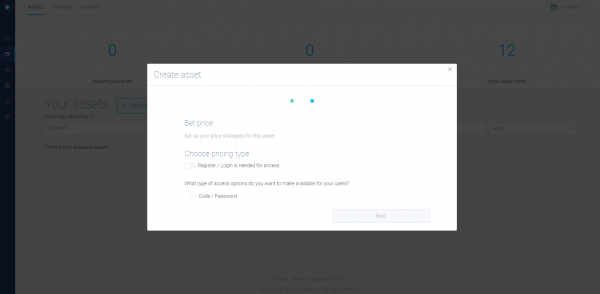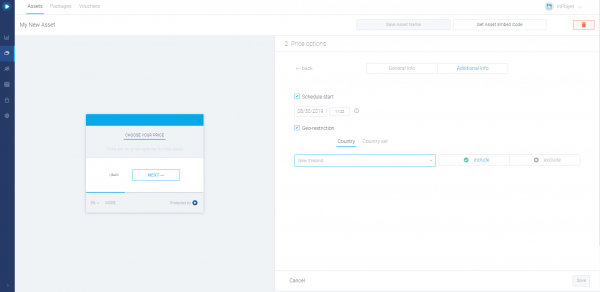In the digital technologically advanced world, one must always be abiding by what the customers want and prefer, and only that principle can make a product successful and user centric. Some of the most essential elements that make a product UI oriented are innovation, navigation, and, of course, interaction design.
To do so, products need to be customer-centric. Every step we take product-wise should involve asking ourselves the question: where does the customer fit into all of this?
When we remember that customer centricity is a journey and not a destination, we’re able to factor the user experience and user interface in from day one. With the customer constantly in mind, we should be able to continually strive for clarity, flexibility and familiarity.
Having this in mind and as more of InPlayer’s merchants have the need to create assets through our merchant dashboard, we agreed that the underlying technology supporting it must be at scale too. That’s why we redesigned InPlayer’s asset management functionalities to give our growing number of merchants unique user experience.
The main goal behind the asset management redesign was two-fold, namely:
1. API Functionality Improvements
On the one hand we wanted to improve the API endpoints used to manage the creation and/or an asset update in our platform. This included decomposing large and complicated endpoints with many parameters that accomplished many functionalities, to smaller, single-purpose and robust endpoints that accomplish a specific functionality. In a way it was a transition from a backend that was hard to manage and complicated to expand with new functionalities, to a more structured backend to which we can add features faster and more reliably.
2. Asset Management UI
On the other hand, we also focused on the UI of the asset management process. Following our backend changes we also wanted to provide a more structured and decomposed flow on the UI, where merchants would be able to clearly manage different asset settings in separate sections. We also focused on providing more space in the design for the management of important asset settings (such as managing prices) to allow merchants to better focus and work faster.
3. Additional UI Features
We’ve also added some features previously available only via API endpoints to the UI, providing merchants with additional options and functionalities.
More specifically:
–access control type setting – merchants can now specify via UI, how their customers can get access to the asset they are managing. Either by sole authentication, authentication and then paying or by entering a valid access code.

–payment type setting – when managing a price for an asset, merchants can now select what payment type is the price, pay-per-view or subscription. This cannot be changed once initially selected.

–schedule start functionality – merchants can now specify a start datetime when content of an asset should start being shown for end-users after purchase. This is the feature that accomplishes the InPlayer Moment product.

–geo-pricing functionality – merchants can now specify a location where a specific price should be displayed or not. You can find more info about our geo-restriction feature in this article.
To keep up with all of InPlayer’s new features, big and small, check out our blog for regular product updates.
In the digital technologically advanced world, one must always be abiding by what the customers want and prefer, and only that principle can make a product successful and user centric. Some of the most essential elements that make a product UI oriented are innovation, navigation, and, of course, interaction design.
To do so, products need to be customer-centric. Every step we take product-wise should involve asking ourselves the question: where does the customer fit into all of this?
When we remember that customer centricity is a journey and not a destination, we’re able to factor the user experience and user interface in from day one. With the customer constantly in mind, we should be able to continually strive for clarity, flexibility and familiarity.
Having this in mind and as more of InPlayer’s merchants have the need to create assets through our merchant dashboard, we agreed that the underlying technology supporting it must be at scale too. That’s why we redesigned InPlayer’s asset management functionalities to give our growing number of merchants unique user experience.
The main goal behind the asset management redesign was two-fold, namely:
1. API Functionality Improvements
On the one hand we wanted to improve the API endpoints used to manage the creation and/or an asset update in our platform. This included decomposing large and complicated endpoints with many parameters that accomplished many functionalities, to smaller, single-purpose and robust endpoints that accomplish a specific functionality. In a way it was a transition from a backend that was hard to manage and complicated to expand with new functionalities, to a more structured backend to which we can add features faster and more reliably.
2. Asset Management UI
On the other hand, we also focused on the UI of the asset management process. Following our backend changes we also wanted to provide a more structured and decomposed flow on the UI, where merchants would be able to clearly manage different asset settings in separate sections. We also focused on providing more space in the design for the management of important asset settings (such as managing prices) to allow merchants to better focus and work faster.
3. Additional UI Features
We’ve also added some features previously available only via API endpoints to the UI, providing merchants with additional options and functionalities.
More specifically:
–access control type setting – merchants can now specify via UI, how their customers can get access to the asset they are managing. Either by sole authentication, authentication and then paying or by entering a valid access code.

–payment type setting – when managing a price for an asset, merchants can now select what payment type is the price, pay-per-view or subscription. This cannot be changed once initially selected.

–schedule start functionality – merchants can now specify a start datetime when content of an asset should start being shown for end-users after purchase. This is the feature that accomplishes the InPlayer Moment product.

–geo-pricing functionality – merchants can now specify a location where a specific price should be displayed or not. You can find more info about our geo-restriction feature in this article.
To keep up with all of InPlayer’s new features, big and small, check out our blog for regular product updates.
Start maximizing the value of your content with InPlayer’s new Landing Page Builder We’ve been building beautiful landing pages for your online events for some time now, but finally you…
Do you want to run reports effectively? Are you wasting too much time on report creation? At InPlayer we care a lot about our customers needs. We have listened closely…
While a substantial volume of content today on the Internet is free, premium and quality content costs more to create and requires different types of content protection models to monetize…